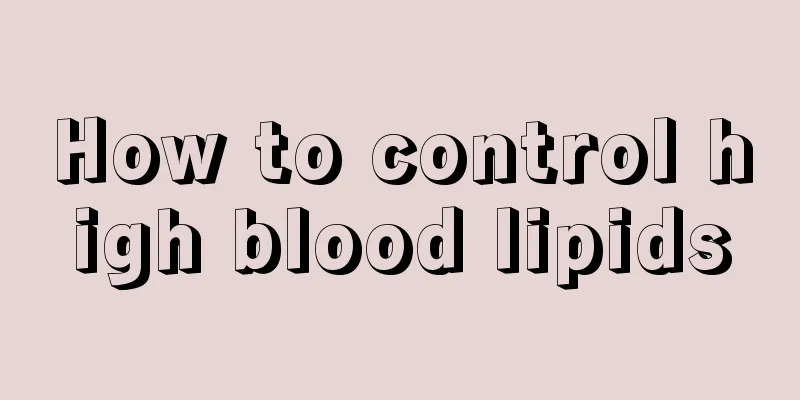How to control high blood lipids

|
If an elderly person often feels dizzy, fatigued, insomniac and forgetful in life, he must go to the hospital to check whether it is caused by high blood lipids. Because high blood lipids have become an important problem that increasingly threatens the health of the elderly in modern life, and high blood lipids may cause atherosclerosis and other diseases, so how should the elderly control high blood lipids? When treating hyperlipidemia through diet therapy, symptomatic diet therapy can be carried out according to its four types. First point Hypercholesterolemia, which accounts for 40% of hyperlipidemia patients, has elevated serum total cholesterol levels, while triglyceride levels are normal, and only blood cholesterol levels are elevated. The principle of diet therapy should be to limit the cholesterol in food. 1 Eat less or avoid foods high in cholesterol, such as animal brains, spinal cords, offal, egg yolks, etc. Eat more foods rich in plant fiber, such as standard flour, corn, oats, etc. These foods can promote intestinal peristalsis and facilitate the excretion of cholesterol. 2 Eat more foods rich in calcium and potassium and low in sodium. Such as taro, potatoes, etc., because potassium salt can increase blood vessel elasticity and has diuretic function, which is beneficial to improve myocardial contractility. Foods rich in calcium include milk, sesame paste, dried shrimps, etc., which also have a protective effect on the cardiovascular system. 3 Eat more green vegetables and fresh fruits rich in vitamin C. Vegetables and fruits can improve myocardial function and blood circulation, facilitate the excretion of cholesterol, and prevent the occurrence of hyperlipidemia. 4 Eat more foods that can lower cholesterol, such as beans and their products, onions, garlic, mushrooms, and fungus. 5. Appropriately increase the intake of seafood, such as kelp, seaweed, marine fish, etc. Drink less alcohol and high-sugar beverages, and drink more tea. Second point Hypertriglyceridemia, accounting for 20% of hyperlipidemia patients, is characterized by elevated serum triglyceride levels and normal total cholesterol levels. Patients with this type have normal cholesterol levels and elevated triglyceride levels. The principle of diet therapy should be to limit food intake and reduce weight. When treating this type of hyperlipidemia through diet, you should pay attention to the following aspects: 1. Limit sweets. Such patients are very sensitive to sugar, and eating sugar will further increase triglyceride levels. Therefore, you should try to eat less or no brown sugar, white sugar, fruit candy, honey, and various sugary foods and medicines. 2 Appropriately limit cholesterol. No more than 300 mg per day, and you can eat up to 3 eggs per week. Other cholesterol-containing foods can also be consumed appropriately, but the total intake should not exceed the above limit. 3. Appropriately increase protein, especially soy protein foods; appropriately limit fat intake, especially animal fat intake. Third Point Combined hyperlipidemia accounts for 40% of hyperlipidemia patients, with increased serum total cholesterol and triglyceride levels. This type of patient has elevated blood cholesterol and triglyceride levels. The key to dietary treatment is to combine the dietary principles of the above two types. That is, appropriately limit cholesterol and animal fat, control food intake to reduce weight, avoid eating sweets and drinking alcohol, appropriately increase vegetable oil, beans and their products, eat more vegetables, fruits and some foods that have a lipid-lowering effect. Fourth point Hypohigh-density lipoproteinemia, decreased serum high-density lipoprotein-cholesterol levels. This type of hyperlipidemia can exist alone or with hypercholesterolemia or hypertriglyceridemia. We should adhere to scientific and reasonable eating habits and insist on eating low-cholesterol and nutritionally balanced foods: 1. Eat more foods rich in protein and unsaturated fatty acids, such as lean meat, grains, vegetables, etc., which can soften blood vessels and lower blood lipids. 2 Eat less fatty meat, dairy products, egg yolks and animal liver, etc. For example, the prostaglandin A contained in onions can increase coronary blood flow and reduce blood viscosity. It is a strong vasodilator and can also reduce and prevent thrombosis. Onions also contain diallyl disulfide compounds and a variety of amino acids, which can lower blood lipids and blood pressure and prevent atherosclerosis and myocardial infarction. |
<<: Is high blood lipid serious?
>>: Bloodletting therapy for hyperlipidemia
Recommend
Does thyroid cancer cause itchy throat?
Thyroid cancer is a malignant tumor that originat...
Can I do scraping on my waist?
Back pain is a common phenomenon in daily life, w...
Early symptoms and precursors of lung cancer
Lung cancer is a malignant tumor that originates ...
How to prevent bladder cancer
The most important thing to prevent bladder cance...
Medicinal pillow treats insomnia
Don't underestimate insomnia, it is a big pro...
The difference between meat crab and roe crab
There is a big difference between meat crabs and ...
Is epilepsy hereditary? Experts say this
Epilepsy is actually epilepsy or seizures, which ...
How to do pneumoperitoneumography
Pneumoperitoneum, also known as artificial pneumo...
What to do if your eyes hurt in the middle of the night
Eyes are the windows to the soul and the tool thr...
How to make cooking oil fragrant
When cooking many foods, cooking oil is needed be...
Pulmonary artery obstruction
Nowadays, many people often have problems with th...
The last symptoms of gallbladder cancer
There are many situations and characteristics of ...
The hazards of sodium hyaluronate
Many cosmetics contain sodium hyaluronate. Long-t...
Under what circumstances does thyroid cancer require surgery
Under what circumstances does thyroid cancer requ...
What is the best way to heal a broken heart?
A broken heart can deal a huge psychological blow ...









